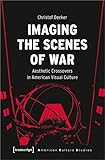Imaging the Scenes of War : Aesthetic Crossovers in American Visual Culture / Christof Decker.
Material type: TextSeries: American Culture Studies ; 38Publisher: Bielefeld : transcript Verlag, [2022]Copyright date: ©2022Description: 1 online resource (160 p.)Content type:
TextSeries: American Culture Studies ; 38Publisher: Bielefeld : transcript Verlag, [2022]Copyright date: ©2022Description: 1 online resource (160 p.)Content type: - 9783839462027
- Aesthetics, Modern -- 20th century
- World War, 1939-1945 -- Art and the war
- World War, 1939-1945 -- Motion pictures and the war
- America
- American Studies
- Cultural Studies
- Image
- Media
- Photography
- USA
- Visual Culture
- Visual Studies
- World War II
- SOCIAL SCIENCE / Media Studies
- America
- American Studies
- Cultural Studies
- Image
- Media
- Photography
- USA
- Visual Culture
- Visual Studies
- World War II
- 420
- D810.A7
- online - DeGruyter
| Item type | Current library | Call number | URL | Status | Notes | Barcode | |
|---|---|---|---|---|---|---|---|
 eBook
eBook
|
Biblioteca "Angelicum" Pont. Univ. S.Tommaso d'Aquino Nuvola online | online - DeGruyter (Browse shelf(Opens below)) | Online access | Not for loan (Accesso limitato) | Accesso per gli utenti autorizzati / Access for authorized users | (dgr)9783839462027 |
Browsing Biblioteca "Angelicum" Pont. Univ. S.Tommaso d'Aquino shelves, Shelving location: Nuvola online Close shelf browser (Hides shelf browser)
Frontmatter -- Contents -- Acknowledgements -- Introduction -- 1 Trauma Narratives, Mixed Media, and the Meditation on the Invisible -- 2 Imaging Axis Terror: War Propaganda and the 1943 The Nature of the Enemy Exhibition at Rockefeller Center -- 3 In Search of a Common Vision: Ben Shahn, Photography, and The Family of Man Exhibition in 1955 -- 4 Transnational Romance: Love and Politics in the Cinema of the 1930s and 1940s -- 5 Poetry and Film, Film as Poetry: Notes on a History of Creative Interactions -- 6 Screening Holocaust: American Television and the Discourse on ‘Victim Cultures’ in West Germany -- Index
restricted access online access with authorization star
http://purl.org/coar/access_right/c_16ec
In American visual culture, the 1930s and 1940s were a key transitional period shaped by the era of modernism and the global confrontation of World War II. Christof Decker demonstrates that the war and its iconography of destruction challenged visual artists to find new ways of representing its consequences. Dealing with trauma and war crimes led to the emergence of complex aesthetic forms and media crossovers. Decker shows that the 1940s were a pivotal period for the creation of horrific yet also innovative representations that boosted American visual modernism and set the stage for debates about the ethics of visual culture in the post-9/11 era.
Mode of access: Internet via World Wide Web.
In English.
Description based on online resource; title from PDF title page (publisher's Web site, viewed 25. Jun 2024)









